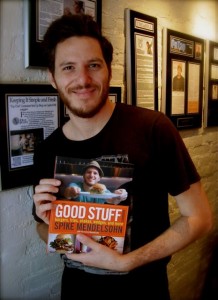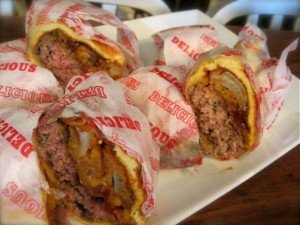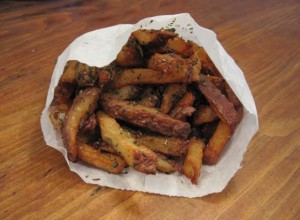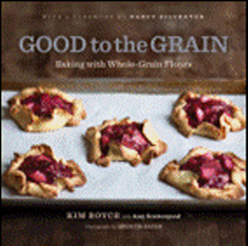Jordan Wright, June 2010

Keeping it real: Spike with his new cookbook - photo by Jordan Wright
Last Monday morning I watched Spike Mendelsohn on ABC’s Good Morning America from the luxury of my bed. He was doing a food demo on the sidewalks of New York with fellow Greek, George Stephanopoulos. Spike’s a down-to-earth real deal guy who’s greatest appeal is, that no matter how famous he has become, he will still shake your hand, look you in the eye and flip your burger. Then he’ll stick around to make sure you liked it.
Five days earlier I spoke with him at The Good Stuff Eatery, his restaurant on Capitol Hill, along with a small group from the press, gathered for the launch of “The Good Stuff Cookbook”. Surrounded by baskets of his Farmhouse Bacon Cheeseburgers, crunchy tender Village Fries, and tall frosty Toasted Marshmallow milkshakes, he is humbled as usual by the attention lavished on him. I’ve always been impressed with Spike, his work ethic and his accessibility. He is naturally giving and open. I’ve watched him jump from behind a searing grill at the Capitol Skyline Hotel pool on the hottest day of summer to hand off a burger and fries to a passing guest. He wants to please everyone.
His new books were stacked for signing on a small table. A word bubble floated aimlessly over my head, “Can a cookbook with hamburger recipes really captivate jaded foodies in a fresh and creative way?” The answer would hang in the air until I returned home.
He begins as most authors do, with acknowledgements of agents’ guidance and chefs’ inspiration. But it is in his warm descriptions of family, and the integral part they have played in his culinary career, that tell of Spike, the man. “The restaurant is the epitome of family,” he avows. His sincerity is palpable.
There is a tender tribute to sister and co-author, Micheline, to whom he writes “To say I could never have done this book without you, is like calling the sky blue.” His grandfather, “Papou, whose love was like an heirloom passed down,” and grandmother, “Zas” who started his love of food and people since the day he first washed dishes in the family’s restaurants, are showered with his adoration and respect. They taught him well. He has become a man who believes in inclusivity, a generous ambassador of his food knowledge and philosophy. Nobody is surprised at this.

Farmhouse bacon cheeseburger - photo by Jordan Wright.
If you’ve ever eaten in his lines-out-the-door Good Stuff Eatery you know that he has reached people by serving honest, homey, un-pretentious food…albeit with an original twist. There are no less than eleven different takes on mayonnaise in the book, from Chipotle to Pomegranate and my personal favorite, Old Bay.
From long-time New Yorker pal and grill partner, Brian, he gets Big B’s Baked Beans. Uncle D’s Chili and Cheddar Burger is a thankful nod to Great Uncle Denny. On the lighter side there are Grilled Watermelon, Yuzu and Feta Salad and Fried Goat Cheese, Dried Cranberry and Almond Wedge Salad…where the Greek influence shines brightly.
The restaurant’s recipe for their popular Village Fries speckled with fresh chopped rosemary and thyme is given here along with the “Michelle Burger”. Hers features ground turkey mixed with mango chutney, green apples and chipotle chiles and served on a multi-grain bun. The “Prez Obama Burger”, pays tribute with a juicy beef burger, applewood-smoked bacon and crumbled blue cheese topped with Horseradish Mayonnaise and Red Onion Marmalade. The Obamas love this place!
Southerners will relish his take on fried chicken in his recipe for Fried Chicken Burger with Smoked Bacon, Gingered Honey Mustard, and Sauteed Collard Greens. It’s a Sunday-go-to-meetin’ supper-on-a-bun.
There are plenty of useful tips throughout the book. Two pages of photos plus directions on cutting perfect onion petals…one of his signature items. It’s his delicious rendition of onion rings that keeps the batter tight to the onion, while the onion petal itself retains its integrity, still meltingly tender and fully cooked. I’ve always wondered how this was done.

Village fries from The Good Stuff Cookbook - photo by Jordan Wright.
Rivetingly lush photographs by Joel Shymanski, capture the intimacy of the moment between the arrival of the hot, smoking, gooey, oozing, herbed, slathered dish and the split second before you pop it in your expectant and salivating mouth. The images taken so close up, you might want to eat the page before you read the recipe.
Many of the dessert recipes are perfect for on-the-go entertaining. Cherry-Apricot Jam Blondies and Vietnamese Coffee Brownies speak directly to the popular “pick-up sweets” geared towards picnics and grill-outs. Imagine Cardamom and Caramel Popcorn on the lawn at your next Wolf Trap concert. Yes, it’s trendy, but oh so cute.
I’m saving the best for last when I tell you that the scrumptious milkshakes, floats and malts served in the restaurant are revealed to the reader. Twenty-two glorious pages of creamy, mouth-watering ice cream treats to freeze your brain. Hallelujah! This stuff is so good it should be illegal. Sign a waiver to yourself before you try it at home. “Plan a party”, Spike entreats his readers. There’s plenty of the “Good Stuff” to go around.
From The Good Stuff Cookbook (John Wiley & Sons, Inc.). Here’s a recipe for Spike’s all-around burger sauce:
Good Stuff Sauce
makes about 2 cups
2 cups Homemade Basic Mayonnaise
2 tablespoons ketchup
2 tablespoons molasses
2 tablespoons rice vinegar
1 teaspoon salt
Add the mayonnaise, ketchup, molasses, vinegar, and salt to a food processor or blender. Puree until smooth. The sauce can be refrigerated in an airtight container for up to 1 week.
For questions or comments on this story contact [email protected] or visit www.WhiskandQuill.com.

